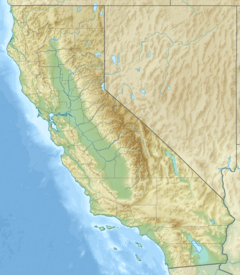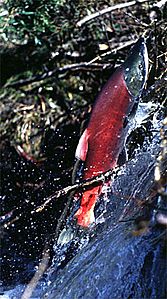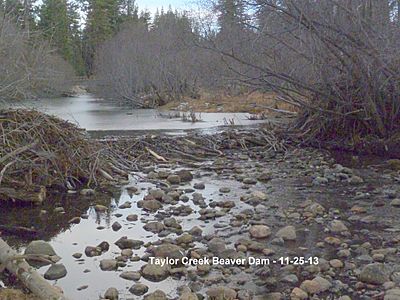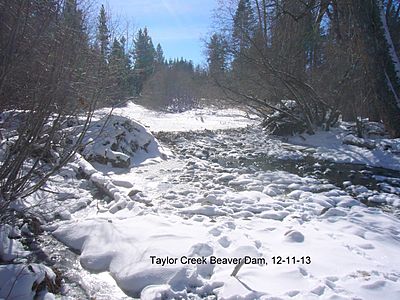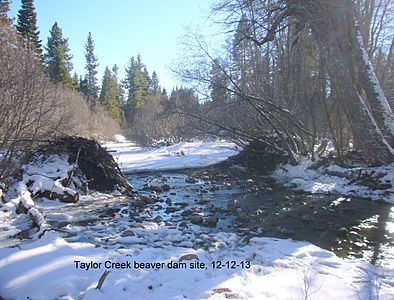Taylor Creek (Lake Tahoe) facts for kids
Quick facts for kids Taylor Creek |
|
|---|---|
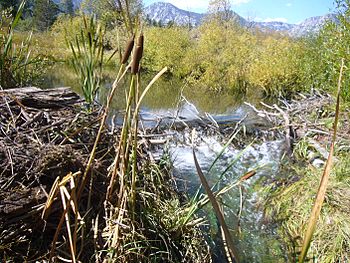
Beaver dams on Taylor Creek are breached by the Forest Service in anticipation of the October Kokanee salmon spawning run.
|
|
|
Location of the mouth within California
|
|
| Native name | Dawgašašíwa (Washoe) |
| Country | United States |
| State | California |
| Region | El Dorado County |
| Physical characteristics | |
| Main source | Fallen Leaf Lake 6,337 ft (1,932 m) 38°55′14″N 120°03′39″W / 38.92056°N 120.06083°W |
| River mouth | Lake Tahoe 6,237 ft (1,901 m) 38°56′26″N 120°03′28″W / 38.94056°N 120.05778°W |
Taylor Creek is a small river, about 2.2 miles (3.5 km) long. It flows north from Fallen Leaf Lake and ends at Baldwin Beach in Lake Tahoe. This creek is located in El Dorado County, California.
Contents
History of Taylor Creek
For the Washoe people, Taylor Creek was known as Dawgašašíwa. It was an important place for them to camp and fish. The creek is likely named after Elijah W. Taylor, who settled nearby in 1864.
Where Taylor Creek Flows
Taylor Creek is the only river that flows out of Fallen Leaf Lake. It starts at a special gate on the north side of the lake. From there, it winds its way north. The creek then flows through the Tallac & Taylor Creek wetland area before reaching Lake Tahoe.
Animals and Plants of Taylor Creek
Taylor and Tallac Creeks create an important wetland area. This area is separate from Lake Tahoe because of Baldwin Beach. In the past, these wetlands offered about 400 acres of habitat for many native animals and plants.
Native Species and Newcomers
The valley between Taylor and Tallac creeks has many old lagoons. These areas used to be wet habitats for different species. However, new species have moved into Taylor and Tallac creeks. These include Eurasian watermilfoil, bullfrogs, and warm-water fish. They now compete with native species.
Native fish include the Lahontan tui chub, Lahontan redside shiner, and Tahoe sucker. A special plant called Tahoe yellowcress also grows here. This wetland is also home to the Sierra Nevada yellow-legged frog. The Lahontan cutthroat trout is another important native species. It is a threatened species, meaning it is at risk of disappearing.
Bringing Back the Lahontan Cutthroat Trout
The Lahontan cutthroat trout (LCT) is the only trout species that naturally lived in Fallen Leaf Lake, Lake Tahoe, and the Truckee River Basin. However, they disappeared because of new fish like lake trout and too much fishing. Efforts to bring back the Lahontan cutthroat trout to Fallen Leaf Lake began in 2006.
The Kokanee Salmon Run
Every autumn, from late September to mid-October, something amazing happens. Mature kokanee salmon swim up Taylor Creek. They change from a silver-blue color to a bright red. As they get ready to lay their eggs, they grow a hump on their back and a hooked jaw.
After laying their eggs, the salmon die. Their bodies become food for other animals. You might see mink, black bears, and bald eagles gathering to feast. These kokanee salmon are not native to Lake Tahoe. They were brought here from the North Pacific in 1944. Taylor Creek is their main place to lay eggs in the Tahoe area.
Beavers and the Creek
Beavers build dams in Taylor Creek. These dams create deep pools of water. However, the United States Forest Service removes these beaver dams every fall. They do this so the kokanee salmon can swim upstream to lay their eggs.
Studies have shown that removing beaver dams can cause problems. It reduces wetland habitat and increases the flow of water. It also adds more phosphorus pollution to Lake Tahoe. This can make the lake's water less clear. Beavers were once common in the Sierra Nevada mountains. Their dams can actually help keep water clean and provide safe, deep places for native cutthroat trout to live in winter. Trout can also easily move around beaver dams.
-
Beaver dam and pond on Taylor Creek taken September 23, 2012.
-
Salmon (Oncorhynchus nerka), the same species as Kokanee salmon, jumping 5 feet (1.5 m) beaver dam in Alaska.
-
North American beaver (Castor canadensis) dam re-built at same site on Taylor Creek, tributary to Lake Tahoe, in winter November 25, 2013.
-
Beaver dams provide critical deep water refugia for native cutthroat trout beneath winter ice December 11, 2013.
Visiting Taylor Creek
You can visit the Stream Profile Chamber at the Taylor Creek Visitor Center. This is a great chance to see the trout and kokanee salmon of Lake Tahoe up close. It is open from Memorial Day weekend through October. The center is on Highway 89, about 1 mile (1.6 km) west of Camp Richardson.


